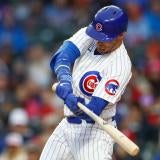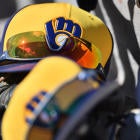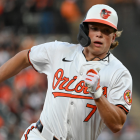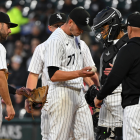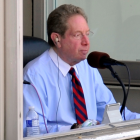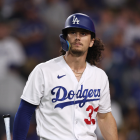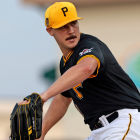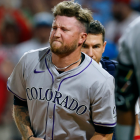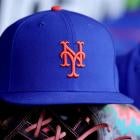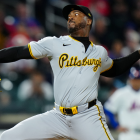With the regular season concluding, we've decided to take a look at each team's future -- not by using a crystal ball or other psychic abilities, but by evaluating their farm systems. Below you'll find our ranking of the top five prospects in the organization -- sorted by perceived future potential -- as well as five other players who fit various categories. Those categories are:
2020 contributor: A player who is likely to play a role for the big-league team next season.
Analyst's pick: A player who is a strong statistical performer and/or whose underlying measures are better than the scouting reports suggest.
Riser: A player on the way up.
Faller: A player on the way down.
One to watch: An interesting player to keep in mind (for whatever reason).
These rankings were compiled after talking with various industry sources about the systems (and players) in question. It should be acknowledged that this process is more art than science, and that there are limits to ordinal rankings. Still, it's an intuitive system, and our hope is that the write-ups will answer any questions by providing additional context and analysis of each player -- such as their pluses and minuses; the risk factors involved; and their estimated arrival date.
One last word on eligibility: we're following MLB's rookie guidelines by disqualifying any player with more than 130 big-league at-bats or 50 innings pitched.
The Brewers have some interesting players in their system, even if it's not a strong group relative to the rest of the league.
1. Brice Turang, SS
The Brewers' first-round pick in 2018, Brice Turang is a quality shortstop and baserunner who has a healthy appreciation for walking. Nevertheless, there are some concerns about his game.
Turang has thus far displayed little power, jumping the fence just four times since being drafted, including all of three times in 564 plate appearances this year. That's a concern because a complete lack of power could cause his hit tool (and keen eye) to play down if pitchers force-feed him strikes without fear of being burned. Turang walking this much -- at least 13 percent in each of his minor-league stops so far -- is a bit worrisome as well, since it may indicate he's too passive at the dish and is letting hittable pitches go by.
This isn't to suggest Turang is without merit -- again, his secondary skills are quality and should permit him a career in reserve, perhaps as a Cliff Pennington type, if nothing else -- but he'll need to show more oomph to ensure a future as a starter and to avoid an empty OBP.
2. Tristen Lutz, OF
The book on Tristen Lutz is straightforward: it's all about the bat.
Lutz, the 34th pick in the 2017 draft, spent the season in High-A, where he hit .255/.335/.419 with 13 home runs. He's a strong-looking right-handed hitter who marries above-average power potential with a willingness to walk. There's legit strikeout potential here, so bear that in mind, but in a perfect world he develops into a quality hitter who is heavy on thumping and walking.
Lutz needs his bat to develop because he's unlikely to make an impact defensively. He does have a good arm, which could land him in right field, he's unlikely to be a standout otherwise. Given that he just turned 21, he should have ample time to mature as needed.
3. Zack Brown, RHP
It's hard to say how much of Zack Brown's struggles in 2019 were caused by the altered baseball, but it's probably fair to say at least some of them.
Brown, a smaller right-hander with a high-effort delivery and broad arsenal, had previously tore through the minors, posting no higher than a 3.39 ERA at any level in which he threw more than 10 innings. That changed this season, as he permitted a 5.79 ERA and 16 home runs in 116 innings -- for reference, he'd yielded 19 home runs in his first two-plus pro seasons combined.
Perhaps blaming the ball for most of Brown's issues is too convenient, but here's to giving him another look in 2020 -- and, for now anyway, maintaining his back-end projection.
4. Ethan Small, LHP
The No. 28 pick in the draft, Ethan Small is a well-constructed southpaw whose delivery almost resembles melded together versions of Clayton Kershaw and Chris Sale's.
Small isn't overpowering, but he releases the ball from an over-the-top slot and imparts good spin on the pitch, allowing his fastball to dodge barrels up and/or above the zone. He also has a couple of quality secondaries that should help his fastball play beyond its so-so velocity.
Deception is a big part of Small's game and he's attuned to that fact. He disrupts timing by altering how long he holds his leg kick, among other tricks that would make the Johnny Cuetos and the Rich Hills of the globe proud.
Small isn't going to ring the doorbell for anyone obsessed with pure stuff alone. He did succeed in the SEC, and heading forward he does have enough stuff and wherewithal to project as a back-end starter. The Brewers have shown an appreciation for unusual profiles -- be it Zach Davies or Brent Suter -- so Small should get a wide berth to make it work.
5. Corey Ray, OF
Corey Ray first joined the Brewers organization in 2016, when he was drafted fifth overall. It's been a long time coming, but he just might make his big-league debut in 2020. Whether or not he goes on to have a notable career afterward is anyone's guess.
Ray seemed to have found something in 2018, homering 27 times in Double-A en route to his finest offensive campaign as a professional. Alas, he suffered a setback in 2019. His performance at Triple-A left much to be desired (he fanned in nearly 40 percent of his trips to the plate), and he missed significant time due to a finger injury.
At Ray's best, he displays above-average raw power and speed. At his worst, he's a swing-and-miss machine with an arm befitting left field. He's already 25 years old and will require protection from the upcoming Rule 5 draft. Maybe he finds his way and becomes a most-days starting outfielder; it seems likelier that he doesn't and is limited to a lesser role.
2020 contributor: Drew Rasmussen, RHP
Drew Rasmussen is a shorter right-hander who has already undergone a pair of Tommy John surgeries. There is, in other words, no reason to play it slow and low with him. The Brewers haven't, enabling him to reach Double-A in his first full professional season. Although Rasmussen was technically a starter for most of the year, the Brewers limited him to fewer than four innings in 23 of his 27 appearances. It's possible they envision using him in a similar role in the future -- think along the lines of an opener, except perhaps one time through the order -- in which his fastball and breaking ball would benefit from shorter spurts, and so would his body.
Analyst's pick: Trey Supak, RHP
The Brewers acquired Trey Supak nearly four years ago in a trade that also netted them Keon Broxton in exchange for Jason Rogers. Good deal. Supak reached Triple-A in 2019, where he struggled to keep the altered ball in the park. His stuff is more average than not, which, along with his build, will likely inspire Lance Lynn comparisons. That's a high bar to clear, and a more realistic expectation is him reaching the majors in 2020 and latching on as a back-end type.
Riser: Mario Feliciano, C
The state of catching is such that any youngster who shows some promise is worth keeping tabs on. To wit, Mario Feliciano rebounded from a tough 2018 to hit .270/.323/.473 across two levels as a 20-year-old. The approach is worrisome -- he tallied nearly five strikeouts per walk -- and he needs to continue to refine his defense, but his age, power potential, and above-average arm give him a chance to be at least a backup. That's enough sometimes. To paraphrase the song: he ain't a Cadillac, and he ain't a Rolls, but there ain't nothing wrong with the radio.
Faller: Braden Webb, RHP
Originally a third-round pick, Braden Webb has the body and the fastball-breaking ball combination to start. Unfortunately, he doesn't have the command. Webb has a complicated delivery -- there's a rocker step, there's crossfire and drop-and-drive action, there's .... -- that would be described as "deceptive" if he were able to locate more consistently. He isn't, however, as evidenced by him walking 48 batters (and hitting another six) in 64 innings. Webb is likely headed for the bullpen sooner than later -- if, for no other reason, than to improve pace of play.
One to watch: Clayton Andrews, LHP/OF
Two-way players are still rare enough that Clayton Andrews earns this spot over Eduardo Garcia despite being the inferior prospect -- plus being listed at 5-foot-6 and not boasting even an average fastball. He split the season between High- and Double-A, compiling a 3.19 ERA and 3.08 strikeout-to-walk ratio in 59 innings while also hitting .333/.391/.381 in 69 plate appearances. He throws from a low three-quarters slot, but performed better against right-handed batters thanks to a quality changeup (he can spin a ball, too). The best guess about Andrews's future role is as a left-handed reliever who slots in sometimes as a defensive and/or pinch-running substitute. He would've been perfect for the Waxahachie Swap.










